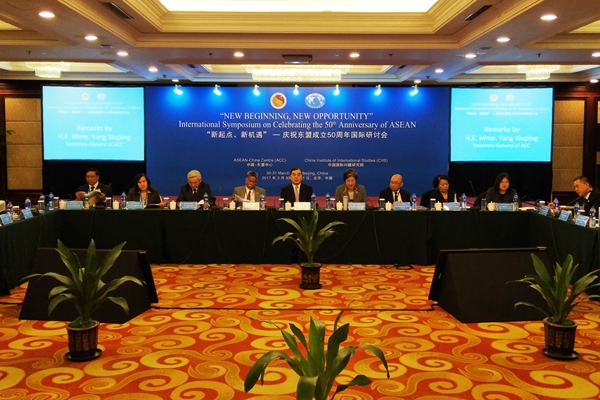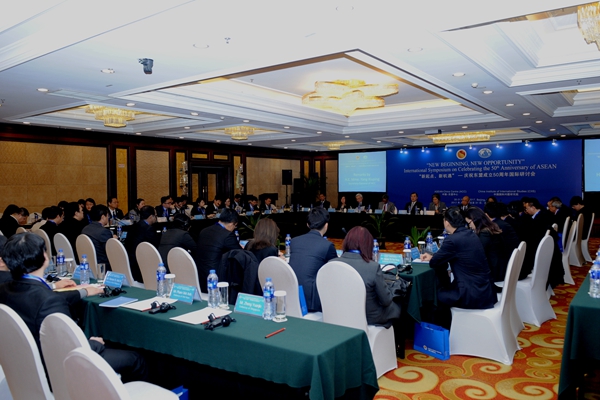
On 30 March 2017, the Opening Ceremony of the “New Beginning, New Opportunity - International Symposium on Celebrating the 50th Anniversary of ASEAN” was launched in Bejing, which was jointly hosted by the ASEAN-China Centre (ACC) and China Institute of International Studies (CIIS). The Opening Ceremony was attended by H.E. A.K.P. Mochtan, Deputy Secretary-General of ASEAN Secretariat, H.E. Mr. Kong Xuanyou, Assistant Minister of Foreign Affairs of China, H.E. Mme. Yang Xiuping, Secretary-General of ACC, Dr. Rong Ying, Vice President of CIIS, and H.E. Ms. Magdalene Teo, Ambassador of Brunei Darussalam, H.E. Mrs. Khek M.Caimealy, Ambassador of Cambodia, H.E. Mr. Thit Linn Ohn, Ambassador of Myanmar, Ms. Elizabeth T. Te, Charge d'affaires ad interim of the Embassy of the Philippines, and other representatives from ASEAN Embassies in China, experts and scholars from ASEAN Member States and China, as well as the media, with a total number of approximately 100 participants.
Secretary-General Yang Xiuping, in her opening remarks, expressed warm welcoming to all participants and thanked friends from all circles of society for their long-term support to ACC. Secretary-General Yang said that ASEAN has made a great leap from turbulence and poverty to stability and development in the past 50 years, and in this process, has formed the unique ASEAN Way and set a good example of seeking strength through unity for countries in the region. ASEAN-China relationship today is among the most robust and dynamic relationships that ASEAN has with its dialogue partners. This relationship has brought tangible benefits to the two peoples. Both ASEAN and China are at a critical period pursuing reform and development, and economic transformation and upgrading. It is important for both sides to adhere to the principle of openness, inclusiveness and mutual benefit, and synergize the ASEAN Economic Community building with the Belt and Road Initiative, so as to expand common interests and realize common development. Secretary-General Yang further hoped the experts and scholars present to contribute more profound thoughts and insights to promoting ASEAN Community building and ASEAN-China practical cooperation.

Vice-President Rong Ying, on behalf of CIIS, extended gratitude to all guests for attending the Symposium, and said that ASEAN has made great achievements in transcending from war, turbulence, and poverty to peace, cooperation and development, and played an important role in maintaining regional peace, stability and prosperity in the past 50 years. ASEAN is now embracing new opportunities and broader prospects. Vice-President Rong also pointed out that ASEAN Community building is entering uncharted water, with no existing model or experience to follow, and can only be advanced by innovation and creativeness. China is pleased to witness ASEAN’s remarkable achievements and willing to join ASEAN in dealing with the uncertainty in international and regional situations and settling the new challenges. Vice-President Rong also hoped experts and scholars presented to offer more constructive perspectives and policy recommendations to advance ASEAN Community building and ASEAN-China relations.
Ms. Elizabeth T. Te, conveyed the remarks from H.E. Jose Sta. Romana, Ambassador of the Philippines. She said that unity and cooperation has been crucial to ASEAN’s collective success. Southeast Asia has become an economic powerhouse. The Philippines, as Chair of ASEAN and in cognizance of the region's achievements for the past five decades, aims to further help achieve the collective aspirations of peoples of Southeast Asia. In this connection, the theme for the Philippines’ Chairmanship of ASEAN is “Partnering for Change, Engaging the World”. The priorities to be addressed this year are: to place ASEAN peoples at the core; to work for regional peace and stability; to pursue maritime security and cooperation; to advance inclusive, innovation-led growth; to strengthen ASEAN resiliency; and to promote ASEAN as a model of regionalism and as a global player. In line with the principles of the ASEAN Community Vision 2025, ASEAN is at the forefront or at the “driver’s seat” in its relations with its dialogue partners including China. China has viewed ASEAN as a priority of neighborhood diplomacy and remains supportive of the ASEAN Community. Being the first country to establish a strategic partnership with ASEAN, and the first to establish a Free Trade Agreement with ASEAN in 2010, China is now ASEAN’s largest trading partner, with an aim to achieve bilateral trade at an amount of US$1 trillion. At last, she wished the Symposium will be a useful forum for exchange of ideas and contribute to the development of ASEAN Community building and ASEAN-China relations.

Assistant Foreign Minister Kong Xuanyou, on behalf of the Ministry of Foreign Affairs of China, congratulated on the opening of the International Symposium, and said that in the past 50 years, ASEAN has achieved remarkable development, become a successful template of strength through unity of countries of different social systems and development levels, identified its central role in East Asia regional cooperation and risen as a force for peace and stability in this region. China has all along seen ASEAN as a priority area in neighborhood diplomacy, and firmly supported ASEAN Community building, its centrality in regional cooperation and a greater role of ASEAN in international and regional affairs. China has full expectation and confidence in the future of ASEAN, and look forward to even greater solidarity, strength and prosperity of ASEAN in the future. China and ASEAN celebrated 25th anniversary of the establishment of China-ASEAN Dialogue Relations last year, and both sides agreed to strengthen strategic communication, deepen practical cooperation and upgrade China-ASEAN cooperation. The theme of this symposium “New Beginning, New Opportunities” is well relevant to where China-ASEAN relations are standing. China is ready to join hands with ASEAN at the new beginning, seize new opportunities and focus on cooperation for development, so as to lift China-ASEAN relations to a higher level. In this connection, both sides should uphold peace and create favorable environment for cooperation, align development plans and enhance convergence of interests, enlarge the circle of friends and encourage cultural and people-to-people exchanges, and promote sub-regional cooperation as a new engine for growth. Both sides should make joint efforts and support each other to realize Chinese dream and ASEAN dream, and enhance the development of China-ASEAN relations.
Deputy Secretary-General Mochtan, in his keynote speech, reviewed the 50 years of the ASEAN journey and said that over the 5 decades of development, ASEAN Community building has entered a new phase called ASEAN 5.0. He pointed out that, in the Political and Security Community building, ASEAN is confronting non-traditional security challenges which are transnational and trans-boundary, terrorism and extremism, and peaceful resolution of conflict; in the Economic Community building, ASEAN needs to further fulfill the aim of an integrated market and promote the advancement of Regional Comprehensive Economic Partnership (RCEP); in Social and Cultural Community building, efforts should be made to enhance the people’s awareness of community building, enable the people benefit more from the economic growth and achieve inclusive and sustainable development. ASEAN is facing three major challenges, namely, cohesiveness, centrality and connectivity. ASEAN way is crucial to meeting such challenges. He also emphasized that China has a long history of friendship with ASEAN and is an important dialogue partner to ASEAN. Nowadays witness new beginnings and new opportunities in ASEAN-China relations. On one hand, both sides should make joint efforts to speed up the negotiation of RCEP and strive to reach a code of conduct in the South China Sea at an early date. On the other hand, both sides should deepen sectoral cooperation and enhance the synergy between ASEAN Connectivity building and the Belt and Road Initiative, so as to make common contribution to fulfillment of ASEAN Community Vision 2025 and “Diamond Decade” of ASEAN-China relations. ASEAN Community building is like a marathon without a finishing line. ASEAN is willing to work together with China to achieve ASEAN dream and China dream.
After the Opening Ceremony, experts and scholars spent one and a half day discussing the topics such as “Fifty Years of ASEAN: Review & Outlook”, “ASEAN-China Cooperation: Experience, Inspiration and Prospects”, “Synergy between ASEAN Economic Community and the Belt and Road Initiative”.